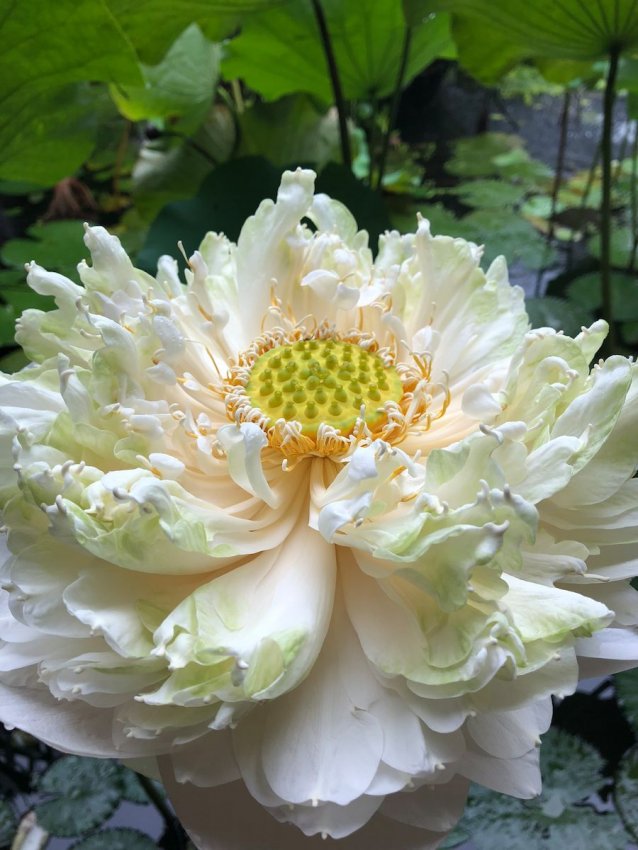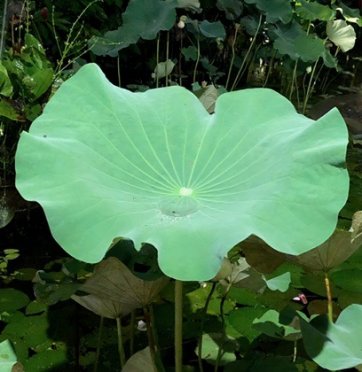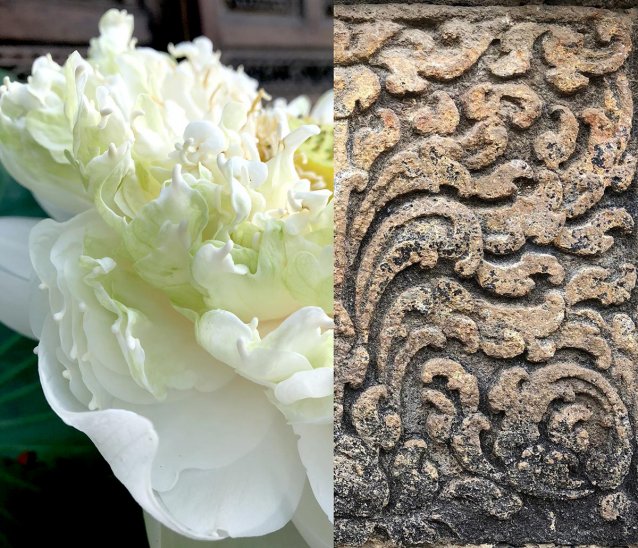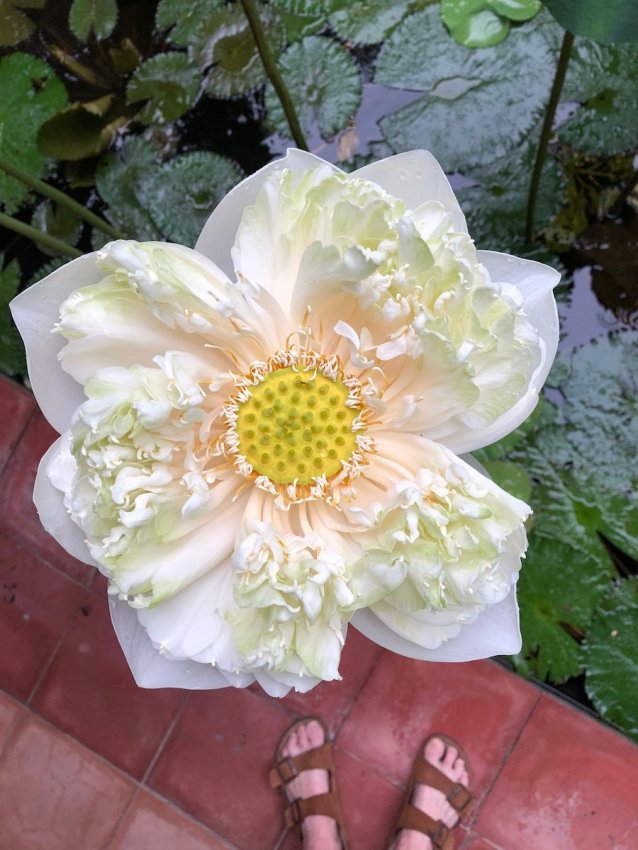I spent much of my summer holiday at D’Omah, a very charming hotel in the village of Tembi in the Regency of Bantul on the outskirts of Yogyakarta in Central Java. D’Omah has rare charm. Lotus and waterlilies sprout in extraordinary profusion in artful ponds amid palms and deep scarlet ginger flowers. Around these relatively informal gardens are arranged open pavilions of mostly traditional Javanese design, affording many indoor-outdoor areas to sit in rapt contemplation. A little street passes through the middle of the property; cockerels crow loudly from even before the first very loud, tape-recorded call to prayer at 4:00 a.m. Long slender chickens and their progeny wander in and out, pecking at grubs and other tasty morsels. Shapely geckos lounge in your rafters, uttering from time to time their quizzical burps of friendliness. The wider surroundings are mostly lush rice paddies.
The stately lotus
by Angus Trumble, 1 February 2018
I have never before had the opportunity to spend any amount of time at close quarters with the lotus, that most spectacular and influential flower. Early on Christmas morning, for example, I had my breakfast right next to the perfect gift: a huge frothing snowy-white to pale-yellow-and-green-and-pink lotus flower, wobbling atop its lofty stalk. To give a sense of scale, plausibly H.M. Queen Elizabeth The Queen Mother could have worn this amazing bloom as a hat; it is exactly that sort of size.
The leaves, meanwhile, are like inside-out umbrellas, and can be at least two feet in diameter. The buds, which are plentiful, swell so quickly that the glorious shape evolves practically before your very eyes. They reach their apogee just as the flower begins to open, coaxed by the heat. It strikes me not as a flower so much as a project, a show, a festival, an invitation to the dance, a sacred rite of initiation—mysterious and teasing, at once frantic but also, I daresay, powerfully seductive. You hear the gamelan, drums and little bells (and, remember, this is only breakfast). To all other flowers that particular lotus seems to be purring in her mellifluous contralto, “Don’t even try, darling; I’ve got it all: structure, texture, inherent variety, colour, shape, rhythm, flesh tones, scale and historical reputation.” In short, the sultry, stately lotus is the Koh-i-noor, the Westminster Abbey, the Berkshire Hathaway, the Annapurna, indeed the Cole Porter of blooms.
However, almost as soon as it produces the flower, the throne of the Buddha—hovering, panting there for about twelve to twenty-four hours (depending upon the rain)—the whole thing collapses, disintegrates, leaving the bright green fruit, the gynaeceum, with its uncanny, striated hemispherical architecture and, just as quickly, droops into a sort of exhausted russet-brown decay. It’s a bit like life, really, when you come to think of it, only compressed into about two days, maybe less.
The exceedingly ancient Buddhist and Hindu civilisations of Central Java owe their existence to two fundamental and, in a way, paradoxical factors. On the one hand there is Merapi, the huge volcano whose regular explosions have for millennia enriched the soil of the surrounding Kedu Plain: Merapi, the mountain of fire, the mother and destroyer also. On the other hand, Java sits exactly half way between the two gigantic lodestars of Asian civilisation: India and China—just as the Republic of Indonesia does today. What is so interesting is that the cultural and spiritual significance of the lotus straddles exactly the same distance—actually far greater.
Lotus ornament and symbolism exist in two separate but closely related forms, depending as they do on separate but related species of waterlily. The lotus motif was central to ancient Egyptian art from at least Dynasty 0, ca. 3200 BCE, and is derived from Nymphaea lotus and Nymphaea caerulea, spikier, slenderer blooms than ours. It travelled thence during the “orientalising” period of the eighth century BCE into ancient Greek ornament, and onward through various phases of Roman and later western art and civilisation. At the same time, the lotus is powerfully present in ancient Sumeria, Mesopotamia, Babylon, Assyria and Persia. Indeed, the name of Hammurabi (ca. 1795−1750 BCE), the great law maker and sixth King of First Dynasty Babylon, may have been derived from the Sumerian phrase “Great Lotus.” In the west, the lotus eventually finds its way into the decoration of the arches of a fine Norman church, that of St. Mary the Virgin (1170 CE), which stands above the River Thames at Iffley in Oxfordshire. It even makes an extraordinary leap-frog via Islamic carpets and porcelain into Italian Renaissance textile design as the “pomegranate,” a fantastic flower encased in an ogee setting, which is in fact a distant and inadvertent reproduction of the stately lotus. Persisting into our time, the lotus even takes up residence in “Burnt Norton,” the first of T. S. Eliot’s Four Quartets (1936), but this is, in fact, the Asian lotus of the second, and even more important lotus tradition.
That tradition goes back at least as far as the pottery of Jōmon Japan (5000−1500 BCE) and arises also in India, in both cases from the plant we know as Nelumbo nucifera, of which sophisticated Chinese and Japanese horticulturalists were producing new cultivars from at least 800 CE. However, it was everywhere throughout the subcontinent and Sri Lanka by the second century BCE. Crucially it travelled with Buddhism from India into Central Asia and back to China and Japan, as indeed it arrived in Java soon afterwards, in the early centuries CE. For millennia the lotus has been sacred to Hindus and Buddhists alike. It is synonymous with Lakshmi, the quintessential Vedic lotus goddess and consort of Vishnu, but its most fully developed cosmogony is Buddhist: Rooted in the mucky deposits at the bottom of the pond, that is, the mud of existence, the lotus sends its stem up through the waters of emptiness and blooms high above them. Thereby it represents the Middle Path, unattached and perfect. The lotus also blooms and bears its fruit simultaneously, which demonstrates the non-duality of cause and effect, being one of the attributes of the Real or “Not-False” Dharma, in other words the state of Buddha-hood. I see now why you would naturally presume the lotus was sacred. There is no better way to get an immediate, real sense of large chunks of Hindu and Buddhist iconography than to spend a little time observing the magnificent lotus. And of course, there it is, about a kilometre from Yogyakarta Airport, inscribed in stone 1,200 years ago on the exquisite little temple of Sambisari (ca. 812–38 CE), an artefact of the remarkable Javanese Mataram Kingdom, looking exactly the same, a moving testament to the lotus’s continuous appeal to the senses.
This is important. I found myself recalling dry passages in art history classics that so tediously referenced lotus ornament but, because I had never observed one in action—really spent time looking closely at it—I quite obviously had no idea; no way of “getting it.” I wonder how many other serious young students of the history of art are similarly missing the point? Here, though, the plant itself supplies the living model for all those shapely finials, vessels, mouldings, friezes, fringes, bases, petal motifs, capitals: the whole box and dice. It travels from ancient Memphis to Athens; from India to the carpets and porcelain of medieval Persia; thence with the Arabs to Córdoba; and from India in the other direction to Burma, Cambodia and Central Java, and onward to imperial China. It passes thence, back and forth, right the way along the silk route (with detours). This is extremely moving because the article on “Lotus” in the Grove Dictionary of Art lays emphasis on the fact that various bodhisattvas, for example, inhabit “highly stylised” lotus; that scrolls of lotus ornament in sixth-century CE Chinese porcelain are “unrealistic,” and so on. What nonsense! You need only spent half a day by the lotus pond to realise that the best examples of such ornament capture exactly the full essentials, the evanescent moods of this most sumptuous and beguiling flower, the behaviour of its leaves, the arabesque profile of its outermost petals, the riot of its inner workings, the perfect structure of its fruit.
As for me, I shall go back to the lotus pond by and by and think a little more.
7 portraits
Related information



The Gallery
Visit us, learn with us, support us or work with us! Here’s a range of information about planning your visit, our history and more!



Support your Portrait Gallery
We depend on your support to keep creating our programs, exhibitions, publications and building the amazing portrait collection!



Plan your visit
Information on location, accessibility and amenities.
















